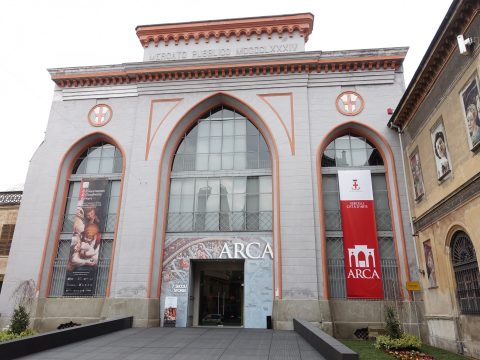The daring Renaissance of Gaudenzio Ferrari
The greatest exhibition about Gaudenzio Ferrari ever organized revolves around three towns: Varallo, Vercelli and Novara. Was it a smart move?
- Vercelli, Arca (ex Chiesa di San Marco).
‘The Renaissance of Gaudenzio Ferrari‘ is not an exhibition like many others. It’s true that we are dealing with an exceptional artist, that there are many extraordinary works of art (more than a hundred) on loan from the best museums in the world, and that the exhibition stems from the studies of two respected art historians like Giovanni Agosti and Japoco Stoppa, helped by Gianni Romano, the foremost expert on Gaudenzio. However, these are not the ‘only’ reasons why the show has already become a milestone. Indeed, instead of taking place in a ‘titled’ museum of some capitals, – as you would expect for such an event – the Renaissance of Gaudenzio Ferrari is occurring in an ideal triangle whose vertices are three little towns, respectively Novara, Vercelli and Varallo.
We are talking about less than 160,000 inhabitants, a rural territory for the most part, whose socio-economic scene deeply differs from those same capitals where, after all, Gaudenzio was theoretically entitled to revive. Think, for example, of the nearby Milan (which in any case it’s close only if you own a car), but also of Paris, Berlin, London or even New York, that are even further away from Gaudenzio’s triangle. For whoever comes from abroad, visiting the exhibition would anyway mean landing in Milan and renting a car, or taking public transports (train + coach + taxi). Hence it’s difficult to expect that foreign visitors will ultimately be more than a few dozen, even if we take into account that it’s Springtime.
The curators have gathered the artist’s earliest works at the Pinacoteca in Varallo; the Church of San Marco in Vercelli houses Gaudenzio’s masterpieces from his artistic ‘maturity’; at the Broletto complex in Novara there are on exhibition works from the most ‘extreme’ years of his career, that is when the artist was active in Milan, where he passed away in 1546. Each of the three sites are also home of some extraordinary unmovable artworks like the nine chapels conceived by Gaudenzio for the Sacred Mount of Varallo, or the marvellous cycle of frescos painted for the Chiesa di Santa Maria delle Grazie (Church of Our Lady of the Graces), also in Varallo. In Vercelli there are the frescoes in the Chiesa di San Cristoforo (Church of Saint Christopher); whereas in Novara the artist painted the polyptychs for the Nativity Chapel in the Basilica di San Gaudenzio. And it is a matter of fact that these are all fundamental works for the author – certainly the most important ones in terms of commitment, results and preservation – which no other museum in the world, however rich, could ever think of exhibiting. On the other hand, it must be said that these works are public and can be visited by anyone for free, any time of the year.
Now the question arises. Given that an exhibition dedicated to Gaudenzio Ferrari is a fundamental step for the European artistic culture; given that navigating the Gaudenzio’s triangle would represent a unique and greatly instructive experience for whoever is used to the more or less similar ritual of visiting big shows in big museums of the world capital cities; and, given that in the contemporary art world the public takes more complicated and expensive trips to see works by much less important authors. Now the question is: was this really the best way to revive Gaudenzio Ferrari? Or, in the words of Walter Barberis, member of the General Council of Compagnia di San Paolo which, together with two heavyweights like Fondazione CRT and Fondazione Cariplo, has supported the project, was this best way ‘to make the general public discover how great Gaudenzio Ferrari was, a Piedmontese painter whose artistic rise still needs to be investigated adequately’?
It goes without saying that the answer depends upon the objectives set by the players involved, that is the banking foundations, the municipalities which took part to the event, but also the art historians, who have had an extraordinary opportunity of researching. Thus, it seems that these objectives are purely cultural, totally free from the art market – the works on loan from private collections are no more than a dozen altogether (none from galleries), and aren’t certainly the most important ones. There it happens that, by taking this stance, the answer becomes at once more complicated. It would have certainly been easier to reach ‘the general public’ Barberis is talking about by bringing Gaudenzio Ferrari if not to the National Gallery or to the Met, at least to Milan, the most international amongst the Italian cities, regardless of the tourist flow. We could perhaps add that the citizens of Novara, Vercelli and Varallo are, or should be, also those who are already the most familiar with Gaudenzio, considering that this is his territory – in Italian you would say ‘it never rains but it pours’. At the end of the day culture is not what a single individual knows about a certain topic, but what the society he/she lives in knows about itself. And certainly the citizens of the Gaudenzio’s triangle have now at their disposal a tool for knowledge of unquestionable quality. The others, that is those who will go to the triangle one way or another, will find out that the art sea is much wider than what it seems if one remains anchored to the very same names.
November 25, 2020

